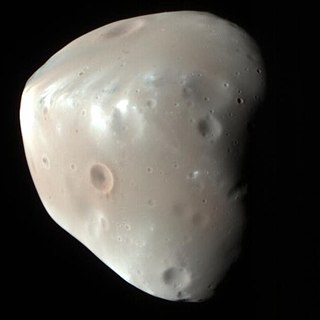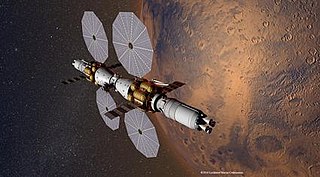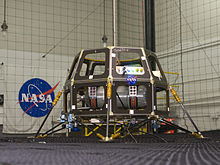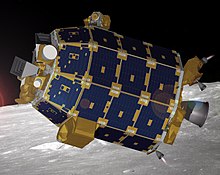
Phobos is the innermost and larger of the two natural satellites of Mars, the other being Deimos. Both moons were discovered in 1877 by American astronomer Asaph Hall. Phobos is named after the Greek deity Phobos, a son of Ares (Mars) and twin brother of Deimos.

Deimos is the smaller and outermost of the two natural satellites of Mars, the other being Phobos. Deimos has a mean radius of 6.2 km (3.9 mi) and takes 30.3 hours to orbit Mars. Deimos is 23,460 km (14,580 mi) from Mars, much farther than Mars's other moon, Phobos. It is named after Deimos, the Ancient Greek god and personification of dread and terror, and who is also a son of Ares and Aphrodite and the twin brother of Phobos.

A lander is a spacecraft that descends towards, comes to rest on, the surface of an astronomical body. In contrast to an impact probe, which makes a hard landing that damages or destroys the probe upon reaching the surface, a lander makes a soft landing after which the probe remains functional.

The Phobos program was an unmanned space mission consisting of two probes launched by the Soviet Union to study Mars and its moons Phobos and Deimos. Phobos 1 was launched on 7 July 1988, and Phobos 2 on 12 July 1988, each aboard a Proton-K rocket.

Nozomi was a Mars orbiter that failed to reach Mars due to electrical failures. The mission was terminated on December 31, 2003.

The Discovery Program is a series of Solar System exploration missions funded by the US National Aeronautics and Space Administration (NASA) through its Planetary Missions Program Office. The cost of each mission is capped at a lower level than missions from NASA's New Frontiers or Flagship Programs. As a result, Discovery missions tend to be more focused on a specific scientific goal rather than serving a general purpose.
The Lunar Precursor Robotic Program (LPRP) is a NASA program that uses robotic spacecraft to prepare for future manned missions to the Moon. The program gathers data such as lunar radiation, surface imaging, areas of scientific interest, temperature and lighting conditions, and potential resource identification.

The two moons of Mars are Phobos and Deimos. They are irregular in shape. Both were discovered by American astronomer Asaph Hall in August 1877 and are named after the Greek mythological twin characters Phobos and Deimos who accompanied their father Ares into battle. Ares, god of war, was known to the Romans as Mars.

A low-energy transfer, or low-energy trajectory, is a route in space that allows spacecraft to change orbits using significantly less fuel than traditional transfers. These routes work in the Earth–Moon system and also in other systems, such as between the moons of Jupiter. The drawback of such trajectories is that they take longer to complete than higher-energy (more-fuel) transfers, such as Hohmann transfer orbits.

The Lunar Atmosphere and Dust Environment Explorer was a NASA lunar exploration and technology demonstration mission. It was launched on a Minotaur V rocket from the Mid-Atlantic Regional Spaceport on September 7, 2013. During its seven-month mission, LADEE orbited around the Moon's equator, using its instruments to study the lunar exosphere and dust in the Moon's vicinity. Instruments included a dust detector, neutral mass spectrometer, and ultraviolet-visible spectrometer, as well as a technology demonstration consisting of a laser communications terminal. The mission ended on April 18, 2014, when the spacecraft's controllers intentionally crashed LADEE into the far side of the Moon, which, later, was determined to be near the eastern rim of Sundman V crater.

The Minotaur V is an American expendable launch system derived from the Minotaur IV, itself a derivative of the LGM-118 Peacekeeper ICBM. It was developed by Orbital Sciences Corporation, and made its maiden flight on 7 September 2013 carrying the Lunar Atmosphere and Dust Environment Explorer spacecraft for NASA.

The Mars Orbiter Mission (MOM), also called Mangalyaan, is a space probe orbiting Mars since 24 September 2014. It was launched on 5 November 2013 by the Indian Space Research Organisation (ISRO). It is India's first interplanetary mission and it made it the fourth space agency to achieve Mars orbit, after Roscosmos, NASA, and the European Space Agency. It made India the first Asian nation to reach Martian orbit and the first nation in the world to do so on its maiden attempt.

The Asteroid Redirect Mission (ARM), also known as the Asteroid Retrieval and Utilization (ARU) mission and the Asteroid Initiative, was a space mission proposed by NASA in 2013. The Asteroid Retrieval Robotic Mission (ARRM) spacecraft would rendezvous with a large near-Earth asteroid and use robotic arms with anchoring grippers to retrieve a 4-meter boulder from the asteroid.

Phobos And Deimos & Mars Environment (PADME) is a low-cost NASA Mars orbiter mission concept that would address longstanding unknowns about Mars' two moons Phobos and Deimos and their environment.

BioSentinel is a planned low-cost CubeSat spacecraft on a astrobiology mission that will use budding yeast to detect, measure, and compare the impact of deep space radiation on DNA repair over long time beyond low Earth orbit.

Mars Base Camp (MBC) is a crewed Mars laboratory orbiter concept under study that was commissioned by NASA from Lockheed Martin in US. It would use both future and proven concepts as well as the Orion MPCV, also built by Lockheed Martin.

LADEE's Lunar Laser Communication Demonstration (LLCD) was a payload on NASA's Lunar Atmosphere and Dust Environment Explorer lunar orbiter.

The Martian Moons eXploration (MMX) is a robotic space probe set for launch in 2024 to bring back the first samples from Mars' largest moon Phobos. Developed by the Japanese Aerospace Exploration Agency (JAXA) and announced on 9 June 2015, MMX will land and collect samples from Phobos once or twice, along with conducting Deimos flyby observations and monitoring Mars' climate.

The Power and Propulsion Element (PPE), previously known as the Asteroid Redirect Vehicle propulsion system, is a planned solar electric ion propulsion module being developed by Maxar Technologies for NASA. It is one of the major components of the Gateway. The PPE will allow access to the entire lunar surface and a wide range of lunar orbits and double as a space tug for visiting craft.



















